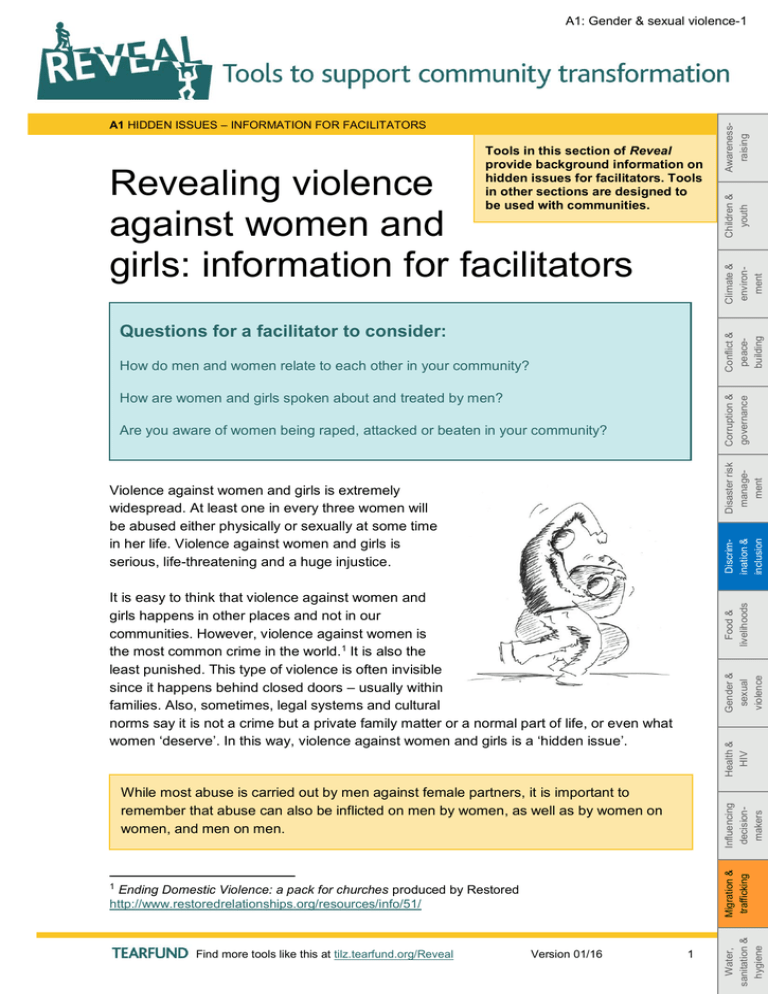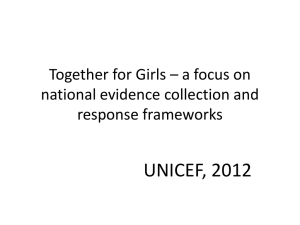
Tools in this section of Reveal
provide background information on
hidden issues for facilitators. Tools
in other sections are designed to
be used with communities.
Climate &
environment
Revealing violence
against women and
girls: information for facilitators
Conflict &
peacebuilding
Questions for a facilitator to consider:
How do men and women relate to each other in your community?
Corruption &
governance
How are women and girls spoken about and treated by men?
Disaster risk
management
Are you aware of women being raped, attacked or beaten in your community?
Discrimination &
inclusion
Violence against women and girls is extremely
widespread. At least one in every three women will
be abused either physically or sexually at some time
in her life. Violence against women and girls is
serious, life-threatening and a huge injustice.
Health &
HIV
Gender &
sexual
violence
Food &
livelihoods
It is easy to think that violence against women and
girls happens in other places and not in our
communities. However, violence against women is
the most common crime in the world. 1 It is also the
least punished. This type of violence is often invisible
since it happens behind closed doors – usually within
families. Also, sometimes, legal systems and cultural
norms say it is not a crime but a private family matter or a normal part of life, or even what
women ‘deserve’. In this way, violence against women and girls is a ‘hidden issue’.
1
Ending Domestic Violence: a pack for churches produced by Restored
http://www.restoredrelationships.org/resources/info/51/
Version 01/16
1
Water,
sanitation &
hygiene
Migration &
trafficking
Influencing
decisionmakers
While most abuse is carried out by men against female partners, it is important to
remember that abuse can also be inflicted on men by women, as well as by women on
women, and men on men.
Find more tools like this at tilz.tearfund.org/Reveal
Children &
youth
A1 HIDDEN ISSUES – INFORMATION FOR FACILITATORS
Awarenessraising
A1: Gender & sexual violence-1
A1: Gender & sexual violence-1
A1 HIDDEN ISSUES - REVEALING VIOLENCE AGAINST WOMEN AND GIRLS
What does the Bible say?
Awarenessraising
Children &
youth
The Bible is clear that God created men and women in his image and therefore they
have equal value and dignity before him (Genesis 1:27–28, 31). Jesus honoured and
respected women (see, for example, Luke 13:10–13), always having time to stop and talk
to them even when it was against the culture to do so (John 4:1–10). Jesus served with
humility and he challenged hypocrites and abusers (John 8:1–11).
Climate &
environment
Conflict &
peacebuilding
The Bible says that God is love and commands Christians to love one another (1 John
4:8 and John 15:12). Indeed, loving relationships in the family and in society are at the
core of Christianity (John 13:34–35). There is no place for abuse within Christian homes
and marriages: the Bible instructs men to love their wives and lay down their lives for
them (Ephesians 5:25). Such sacrificial love cannot sit side by side with abuse. Christian
marriages should be characterised by the fruits of the Spirit: love, joy, peace, patience,
kindness, goodness, faithfulness, gentleness and self-control (Galatians 5:22–23).
For Bible studies on this issue, please see Section B of Reveal.
Corruption &
governance
Understanding violence against women and girls (VAWG)
Disaster risk
management
VAWG usually happens when men assert their power, authority and control over women in
ways which are abusive or violent. These include:
Discrimination &
inclusion
Food &
livelihoods
Gender &
sexual
violence
Health &
HIV
Influencing
decisionmakers
physical violence – when women are
pushed, grabbed, restrained, punched,
beaten, burned or murdered
sexual violence – when they are forced to
engage in sexual activity, treated as a sex
object or have their sex organs mutilated.
Rape and other forms of sexual violence can
happen within marriage.
reproductive control – when they are forced
to have or not have children, denied access
to family planning methods or forced to go
through sterilisation or other invasive procedures
threats and intimidation – threats can include being abandoned or becoming poor. They
may also include physical violence, or suicide
economic control – unfair control of household income and assets, preventing a woman
from obtaining or keeping a job, or taking money or other possessions from her
isolation – when a man controls whom a woman sees and talks to. Women may be kept
from spending time with friends or family
emotional abuse or bullying – when women are insulted, demeaned or manipulated.
Migration &
trafficking
Water,
sanitation &
hygiene
Find more tools like this at tilz.tearfund.org/Reveal
2
A1: Gender & sexual violence-1
A1 HIDDEN ISSUES - REVEALING VIOLENCE AGAINST WOMEN AND GIRLS
Corruption &
governance
Influencing
decisionmakers
Health &
HIV
Women who are abused need love and
compassion. They may need healthcare,
emotional and social support and security. They
may also need to be protected, and there may be
a need for activities to be undertaken to tackle the
causes and factors that contribute to VAWG in a
particular setting.
The IASC Taskforce on Gender in Humanitarian Assistance (2005) Guidelines for genderbased violence interventions in humanitarian settings
3
Water,
sanitation &
hygiene
Migration &
trafficking
2
Find more tools like this at tilz.tearfund.org/Reveal
Disaster risk
management
Gender &
sexual
violence
Women and girls who suffer from violence (sometimes called ‘survivors’) need help to cope
with the harmful consequences. Survivors of violence are at high risk of severe and longlasting health problems, including HIV and other sexually transmitted infections. They are
sometimes at risk of dying from their injuries and at greater risk of committing suicide.
Psychological trauma, as well as social stigma and rejection, is also common. Most societies
tend to blame the victim in cases of sexual violence, which increases psychological harm.2
Discrimination &
inclusion
How does VAWG affect people?
Food &
livelihoods
VAWG doesn’t only happen within the home.
Each year, 60 million girls are sexually
assaulted travelling to and from school, or
within the ‘safety’ of their school. Women and
girls can also be vulnerable to abuse in other
places: for example, when travelling to the
market, at latrines or bathing facilities, or when
collecting firewood, crops or water. Women are
particularly vulnerable in conflict or emergency
situations.
Conflict &
peacebuilding
Climate &
environment
Children &
youth
Awarenessraising
‘Domestic abuse’ or ‘domestic violence’
occurs when one or more of the types of
abuse listed above happens within an
intimate or family-type relationship. The term
refers to a pattern of coercive and controlling
behaviour. This can include forced marriage
and so-called ‘honour crimes’ which can lead
to murder. Domestic abuse happens across
different countries and cultures. It happens in
rich families and poor families. It happens in
church families as well as in wider society.
A1: Gender & sexual violence-1
A1 HIDDEN ISSUES - REVEALING VIOLENCE AGAINST WOMEN AND GIRLS
Awarenessraising
All forms of violence against women are wrong and must be challenged. Christians need to
be leading the way in transforming communities through restored relationships between men,
women, boys and girls.
Using Reveal
Children &
youth
Reveal includes tools to help you work with communities to begin to raise and address
VAWG. You can find these in Section A2. You can find Bible studies about this issue in
Section B.
Climate &
environment
Finding out more
Ending Domestic Violence: a pack for churches produced by Restored, an international Christian alliance to
transform relationships and end violence against women
http://www.restoredrelationships.org/resources/info/51/
Conflict &
peacebuilding
Corruption &
governance
Disaster risk
management
Discrimination &
inclusion
Related tools:
A1 – Revealing female genital mutilation – information for facilitators [A1: Gender & sexual
violence-2]
A1 – Revealing inequality between men and women – information for facilitators [A1: Gender &
sexual violence-3]
B – Gender and restoring relationships (Bible study) [B: Gender & sexual violence-1]
B – Wonderfully made (FGM/C) [B: Gender & sexual violence-2]
B – God’s view of women (Bible study) [B: Gender & sexual violence-3]
B – God’s view of men (Bible study) [B: Gender & sexual violence-4]
B – Men, women and God (Bible study) [B: Gender & sexual violence-5]
B – Protecting those vulnerable to sexual violence [B: Gender & sexual violence-7]
B – Sexual violence in the Bible – the story of Tamar [B: Gender & sexual violence-8]
Food &
livelihoods
Gender &
sexual
violence
Health &
HIV
Influencing
decisionmakers
Migration &
trafficking
Water,
sanitation &
hygiene
Find more tools like this at tilz.tearfund.org/Reveal
4







